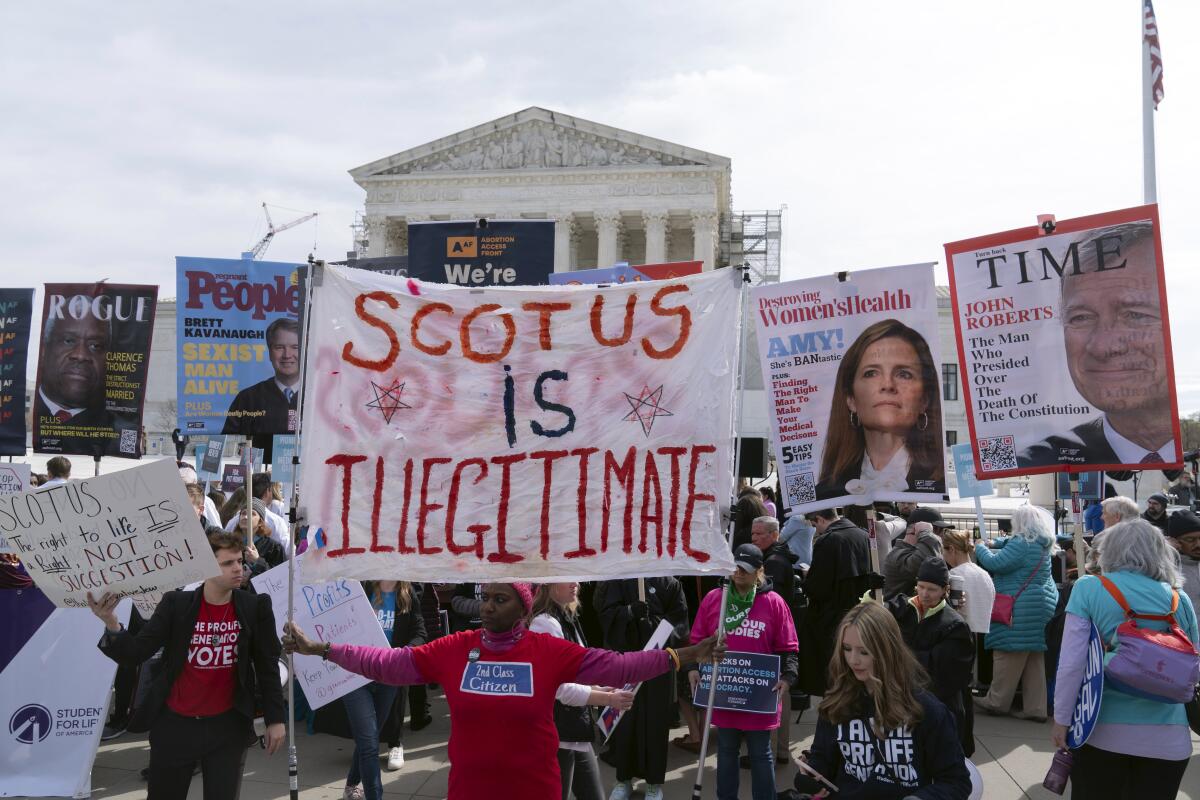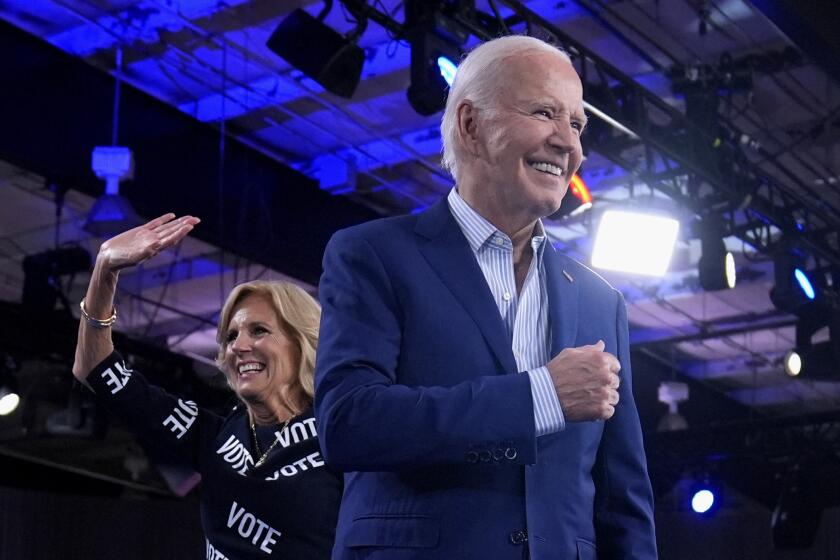Column: Supreme Court plays kick the can with two big cases

Hello and happy Thursday. There are 130 days until the election. Today we’re talking about flies, lies and kicking the can.
First, flies. The presidential debate is tonight, and obviously, no good will come of that. But all I can think about is the 2020 Pence-Harris debate when a big black fly landed on Pence’s snow white hair.
It was mesmerizing, in all of the most terrible ways. For two minutes, that fly sat there daring us not to notice. It wobbled, it shook. And most of all, it stayed.
The fly, whom I’ll call Marty, for no real reason, inspired endless memes and even a bobblehead.
Within hours, President Biden put out a fundraising commercial peddling “Truth over Flies” swatters for a $5 donation.
So the lesson here is that the only thing that will matter tonight is the Marty moment — that unplanned viral sensation that will eclipse all else.
Now, on to a Supreme Court that is trying very hard to not make decisions, even when it is making them.
You're reading the L.A. Times Politics newsletter
Anita Chabria and David Lauter bring insights into legislation, politics and policy from California and beyond. In your inbox three times per week.
You may occasionally receive promotional content from the Los Angeles Times.

Abortion mistake
The Supreme Court on Wednesday accidentally posted a high-profile ruling on abortion — no doubt bringing back some Dobbs PTSD (that decision was leaked early by a still-unknown source).
Bloomberg Law grabbed a copy before the court caught its error, so we get a sneak peek at a case that will likely come down officially Thursday. It’s a combined ruling in two cases: Moyle vs. United States and Idaho vs. United States.
But (as I wrote about before) it’s better known as the EMTALA case — short for the Emergency Medical Treatment and Active Labor Act.
In bare basics, Idaho wanted to ban nearly all abortions, including ones in emergency rooms done to save a woman from severe health harms. Note to self: Idaho sucks.
The U.S. government, in basically a Hail Mary effort, tried to stop that retrograde law by invoking a Reagan-era law meant to prevent patient dumping and forcing emergency rooms to provide critical care. Because federal laws are supposed to supersede state laws, it thought it had a chance.
If the leaked court decision is in fact its final one (likely), the Supreme Court didn’t rule in favor of the U.S. government, but also “definitely did not” give a win to the antiabortion contingent, Mary Ziegler told me.
She’s a professor at UC Davis and a national expert on abortion rights.
In a move that has become increasingly frequent, the court instead pushed the decision off to a future case by ruling that this one was “improvidently granted,” which just means it shouldn’t have landed in front of them in the first place.
“They’re not deciding anything on the merits,” Ziegler said, and Idaho will at least temporarily have to provide some abortions in emergency rooms while lower courts figure it out, or another case makes its way to the Supreme Court.
So the justices kicked the can — far into a non-election year.
That means there won’t be a bombshell abortion ruling to rile the masses this summer, as the Democrats were hoping.
The most interesting part of the decision, Ziegler said, was that the six-justice conservative bloc of the court seemed to split on the case, meaning “three of the conservatives are not ready to go as far as the rest of the conservatives.”
Which, I guess, is good? Or at least the best we’ve got.
Another can kicked
Justices also put out a decision on a case known as Murthy vs. Missouri, this one on purpose.
It’s not as high-profile as some of the other decisions expected this week, but it’s more important than we’re giving it credit for.
After the 2020 election and during the pandemic, the federal government reached out to social media sites asking them to take down misinformation and disinformation (i.e. lies and propaganda), especially around the COVID-19 virus.
You may remember this as the QAnon era when nice folks lost their minds. “Q” was dropping “hints” about some deep state, international scheme by Democrats to become overlords of the human race. There was also a ton of antisemitism and, for fun, lizard people.
(The poop-storm of social media insanity also included anti-vax garbage from presidential wannabe Robert Kennedy Jr., who is pushing his own case on the issue: Kennedy vs. Biden.)
In Murthy vs. Missouri, two right-wing attorneys general from Louisiana and Missouri and some conservative private plaintiffs sued the federal government for flagging these kinds of posts to the social media sites, arguing the feds didn’t have a right to do that because it violated the 1st Amendment and was government censorship.
And like EMTALA, the justices didn’t actually decide much about censorship or propaganda other than they didn’t want to decide anything.
They ruled that Missouri, Louisiana and the other plaintiffs lacked standing. Meaning nothing bad had happened to any of them, so they can’t complain to the courts about it.
“Neither the states nor the individual social media users were able to prove — or even allege — that government agencies’ or officials’ actions caused them any injury,” Lisa Macpherson, policy director at think thank Public Knowledge, said in a statement.
So again, important issues — what is free speech and what can the government do to counter lies and propaganda without infringing on it? — that the court wants no part of.
That’s good and bad news.
Mia Bloom, a professor and disinformation expert at Georgia State University, said that it’s “good for Biden because it challenges the far-right narrative that the Dems have weaponized social media.”
She points out that most of the misinformation and disinformation online is coming from right-wing sources. But at the same time, the far right constantly claims that it’s the left that is circulating lies. They even convened a congressional panel on the issue and have hounded experts in an effort to kill off attempts to curb this kind of social media spin.
But, said Joan Donovan, an expert in disinformation and a professor at Boston University, a non-ruling just leaves chaos and fear — the government may now be allowed to return to flagging suspicious or deceitful posts and sending requests for their removal to social media platforms, but will they want to?
“No individual wants to be the subject of a smear campaign for having informed a social media company about nefarious activity on their platform,” said Donovan, pointing out it’s unlikely individual civil servants will want to make themselves targets.
That just emboldens those who already have become frighteningly adept at manipulating not just people, but reality.
“Disinformation today is a political strategy using online platforms as infrastructure for mass propaganda campaigns,” Donovan warned.
What else you should be reading
The must-read: Supreme Court appears poised to allow, for now, emergency abortions in Idaho
The “Of course they do”: Republicans rally behind Trump after conviction, Times/Siena Poll finds
The L.A. Times special: Trump wants mass deportations. Can Biden sell a more nuanced approach during the debate?
Stay Golden,
Anita Chabria
P.S. Here’s a smiling great white shark caught by marine photographer Eric Mailander in Monterey Bay.

Was this newsletter forwarded to you? Sign up here to get it in your inbox.
Get the L.A. Times Politics newsletter
Deeply reported insights into legislation, politics and policy from Sacramento, Washington and beyond. In your inbox three times per week.
You may occasionally receive promotional content from the Los Angeles Times.




